Exploring experience of young healthcare professionals in providing treatment to vulnerable patients with chronic conditions
VerifiedAdded on 2023/06/09
|12
|3762
|77
AI Summary
This research aims to explore the experience of young healthcare professionals in providing treatment to vulnerable patients with chronic conditions. The research will analyse the role of young healthcare professionals, evaluate the challenges faced by them, and examine the strategies used by them in providing treatment to vulnerable patients. The research will help in formulating care providing strategies that can be helpful in meeting the care and health needs of the vulnerable patients by making the process more efficient.
Contribute Materials
Your contribution can guide someone’s learning journey. Share your
documents today.
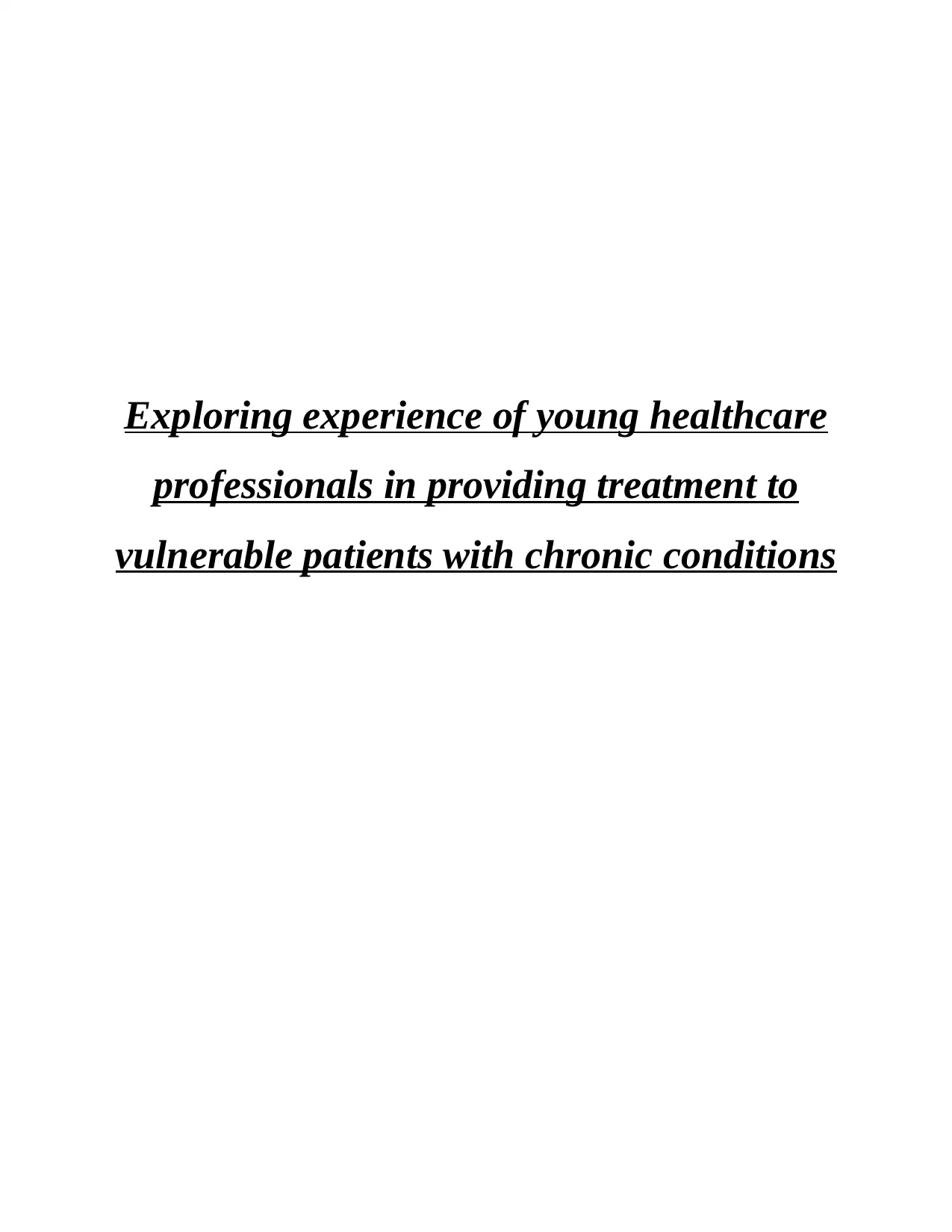
Exploring experience of young healthcare
professionals in providing treatment to
vulnerable patients with chronic conditions
professionals in providing treatment to
vulnerable patients with chronic conditions
Secure Best Marks with AI Grader
Need help grading? Try our AI Grader for instant feedback on your assignments.
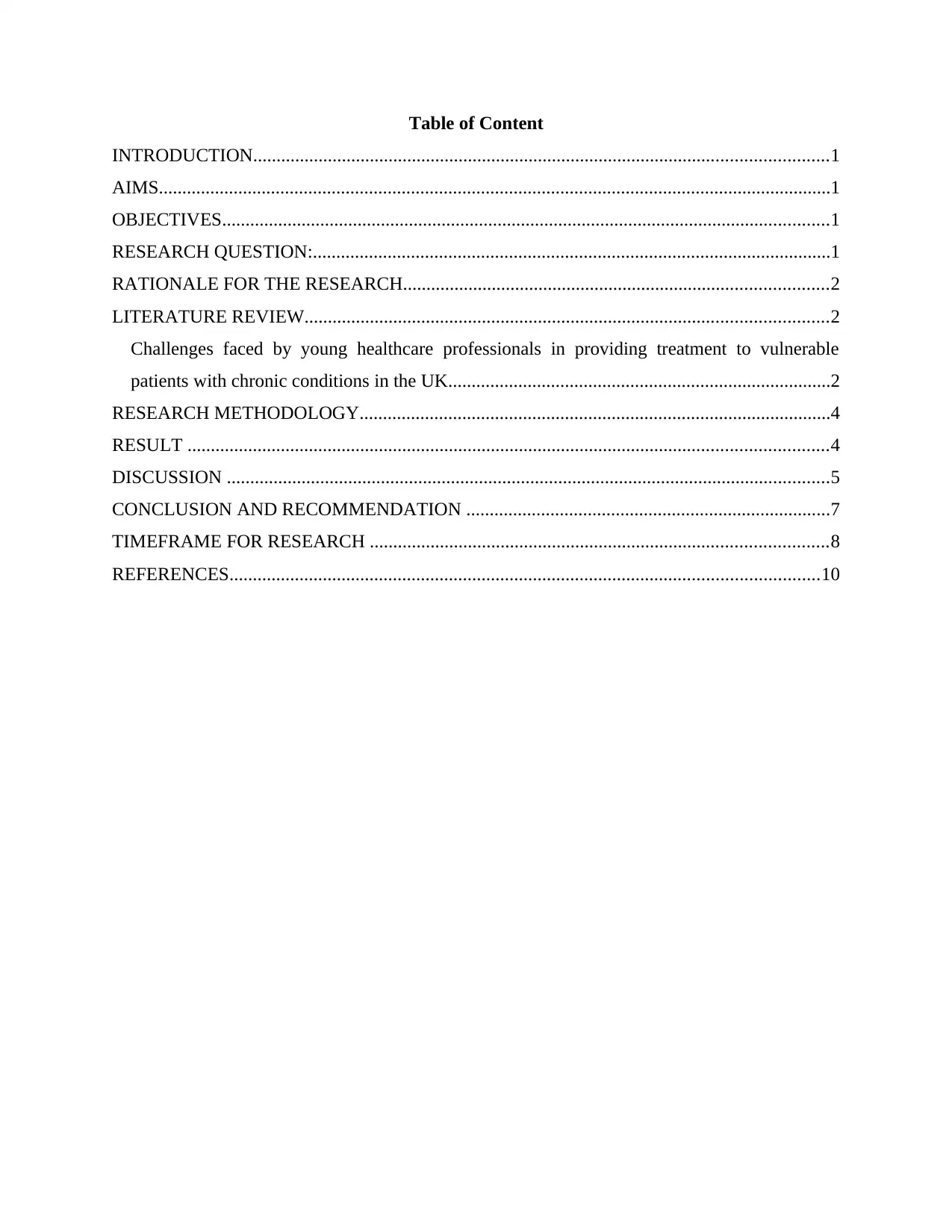
Table of Content
INTRODUCTION...........................................................................................................................1
AIMS................................................................................................................................................1
OBJECTIVES..................................................................................................................................1
RESEARCH QUESTION:...............................................................................................................1
RATIONALE FOR THE RESEARCH...........................................................................................2
LITERATURE REVIEW................................................................................................................2
Challenges faced by young healthcare professionals in providing treatment to vulnerable
patients with chronic conditions in the UK..................................................................................2
RESEARCH METHODOLOGY.....................................................................................................4
RESULT .........................................................................................................................................4
DISCUSSION .................................................................................................................................5
CONCLUSION AND RECOMMENDATION ..............................................................................7
TIMEFRAME FOR RESEARCH ..................................................................................................8
REFERENCES..............................................................................................................................10
INTRODUCTION...........................................................................................................................1
AIMS................................................................................................................................................1
OBJECTIVES..................................................................................................................................1
RESEARCH QUESTION:...............................................................................................................1
RATIONALE FOR THE RESEARCH...........................................................................................2
LITERATURE REVIEW................................................................................................................2
Challenges faced by young healthcare professionals in providing treatment to vulnerable
patients with chronic conditions in the UK..................................................................................2
RESEARCH METHODOLOGY.....................................................................................................4
RESULT .........................................................................................................................................4
DISCUSSION .................................................................................................................................5
CONCLUSION AND RECOMMENDATION ..............................................................................7
TIMEFRAME FOR RESEARCH ..................................................................................................8
REFERENCES..............................................................................................................................10
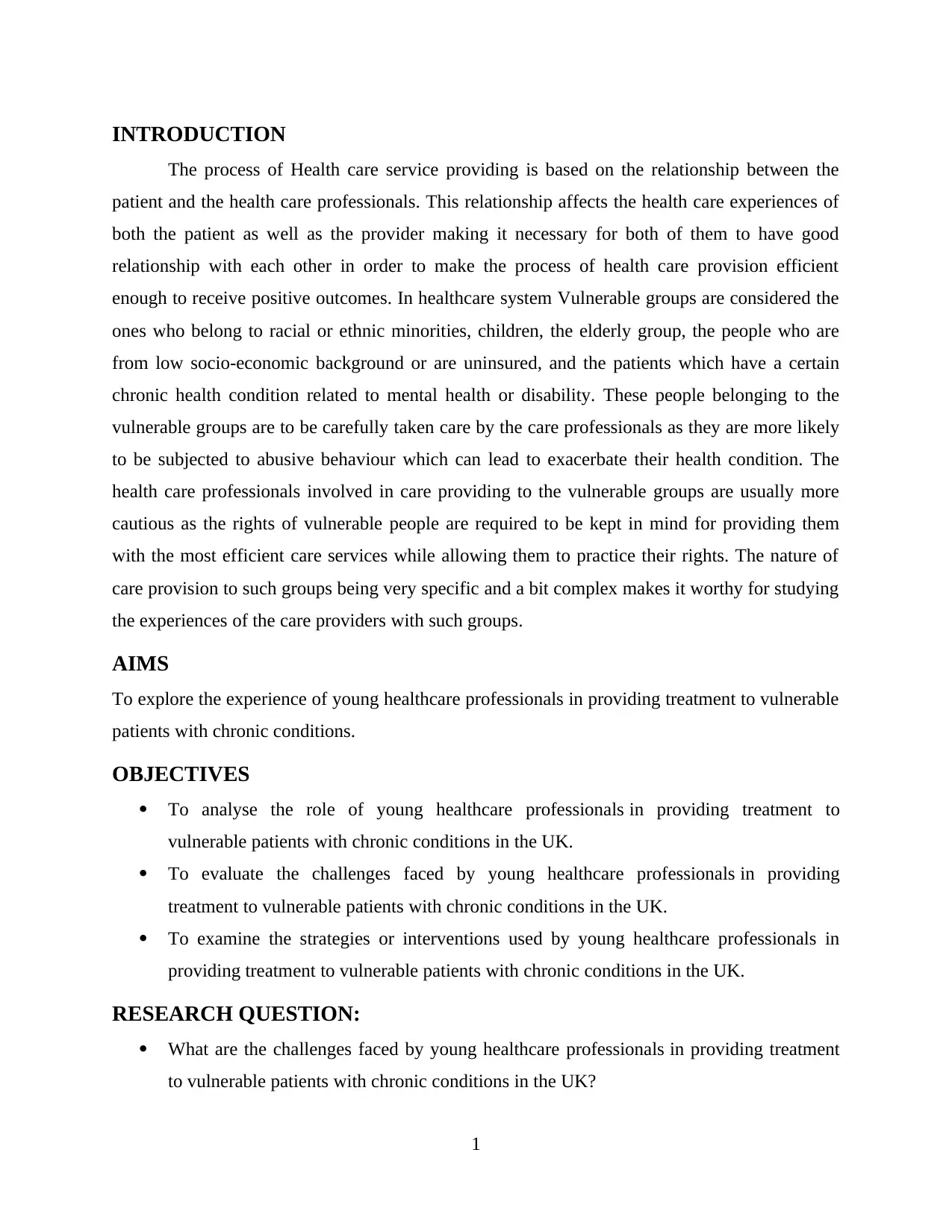
INTRODUCTION
The process of Health care service providing is based on the relationship between the
patient and the health care professionals. This relationship affects the health care experiences of
both the patient as well as the provider making it necessary for both of them to have good
relationship with each other in order to make the process of health care provision efficient
enough to receive positive outcomes. In healthcare system Vulnerable groups are considered the
ones who belong to racial or ethnic minorities, children, the elderly group, the people who are
from low socio-economic background or are uninsured, and the patients which have a certain
chronic health condition related to mental health or disability. These people belonging to the
vulnerable groups are to be carefully taken care by the care professionals as they are more likely
to be subjected to abusive behaviour which can lead to exacerbate their health condition. The
health care professionals involved in care providing to the vulnerable groups are usually more
cautious as the rights of vulnerable people are required to be kept in mind for providing them
with the most efficient care services while allowing them to practice their rights. The nature of
care provision to such groups being very specific and a bit complex makes it worthy for studying
the experiences of the care providers with such groups.
AIMS
To explore the experience of young healthcare professionals in providing treatment to vulnerable
patients with chronic conditions.
OBJECTIVES
To analyse the role of young healthcare professionals in providing treatment to
vulnerable patients with chronic conditions in the UK.
To evaluate the challenges faced by young healthcare professionals in providing
treatment to vulnerable patients with chronic conditions in the UK.
To examine the strategies or interventions used by young healthcare professionals in
providing treatment to vulnerable patients with chronic conditions in the UK.
RESEARCH QUESTION:
What are the challenges faced by young healthcare professionals in providing treatment
to vulnerable patients with chronic conditions in the UK?
1
The process of Health care service providing is based on the relationship between the
patient and the health care professionals. This relationship affects the health care experiences of
both the patient as well as the provider making it necessary for both of them to have good
relationship with each other in order to make the process of health care provision efficient
enough to receive positive outcomes. In healthcare system Vulnerable groups are considered the
ones who belong to racial or ethnic minorities, children, the elderly group, the people who are
from low socio-economic background or are uninsured, and the patients which have a certain
chronic health condition related to mental health or disability. These people belonging to the
vulnerable groups are to be carefully taken care by the care professionals as they are more likely
to be subjected to abusive behaviour which can lead to exacerbate their health condition. The
health care professionals involved in care providing to the vulnerable groups are usually more
cautious as the rights of vulnerable people are required to be kept in mind for providing them
with the most efficient care services while allowing them to practice their rights. The nature of
care provision to such groups being very specific and a bit complex makes it worthy for studying
the experiences of the care providers with such groups.
AIMS
To explore the experience of young healthcare professionals in providing treatment to vulnerable
patients with chronic conditions.
OBJECTIVES
To analyse the role of young healthcare professionals in providing treatment to
vulnerable patients with chronic conditions in the UK.
To evaluate the challenges faced by young healthcare professionals in providing
treatment to vulnerable patients with chronic conditions in the UK.
To examine the strategies or interventions used by young healthcare professionals in
providing treatment to vulnerable patients with chronic conditions in the UK.
RESEARCH QUESTION:
What are the challenges faced by young healthcare professionals in providing treatment
to vulnerable patients with chronic conditions in the UK?
1
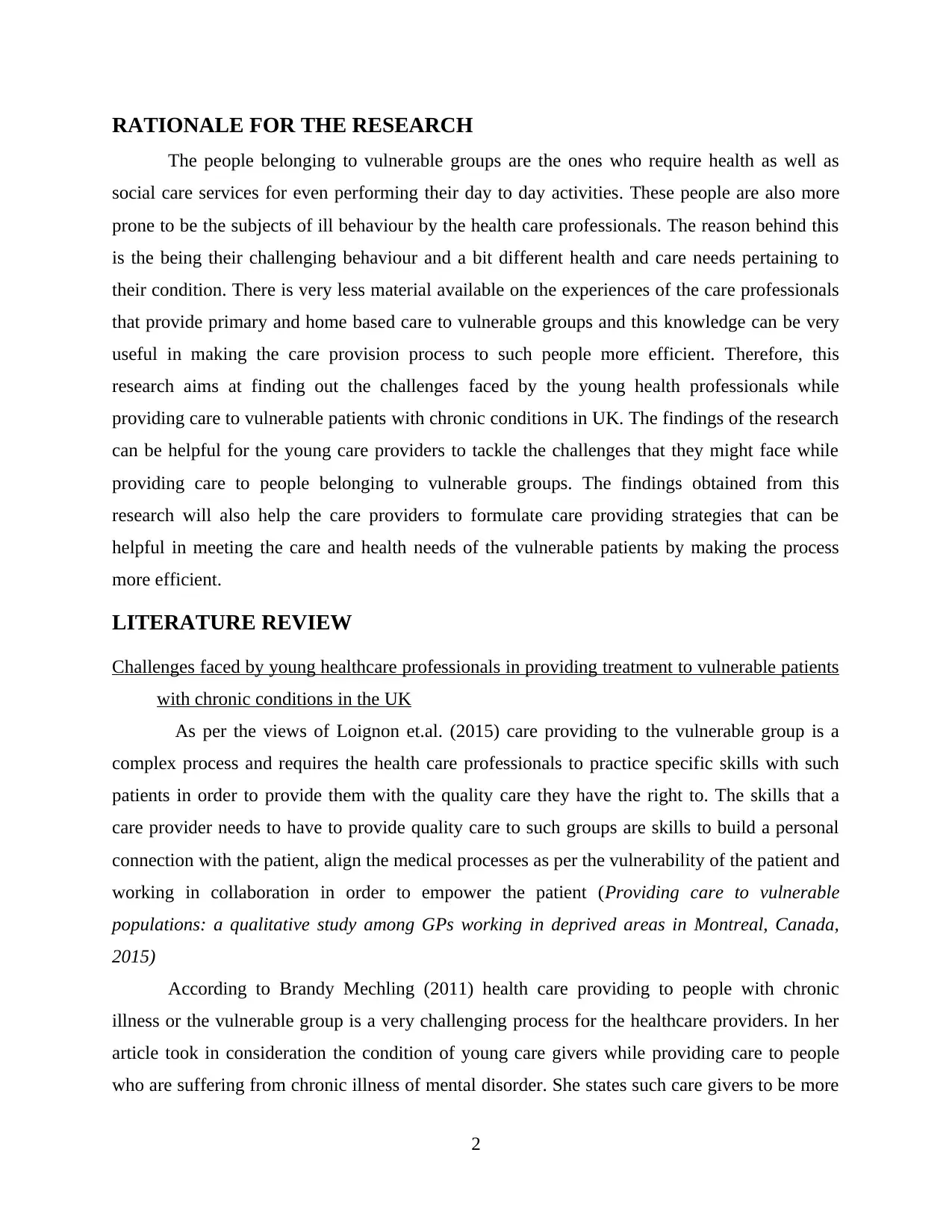
RATIONALE FOR THE RESEARCH
The people belonging to vulnerable groups are the ones who require health as well as
social care services for even performing their day to day activities. These people are also more
prone to be the subjects of ill behaviour by the health care professionals. The reason behind this
is the being their challenging behaviour and a bit different health and care needs pertaining to
their condition. There is very less material available on the experiences of the care professionals
that provide primary and home based care to vulnerable groups and this knowledge can be very
useful in making the care provision process to such people more efficient. Therefore, this
research aims at finding out the challenges faced by the young health professionals while
providing care to vulnerable patients with chronic conditions in UK. The findings of the research
can be helpful for the young care providers to tackle the challenges that they might face while
providing care to people belonging to vulnerable groups. The findings obtained from this
research will also help the care providers to formulate care providing strategies that can be
helpful in meeting the care and health needs of the vulnerable patients by making the process
more efficient.
LITERATURE REVIEW
Challenges faced by young healthcare professionals in providing treatment to vulnerable patients
with chronic conditions in the UK
As per the views of Loignon et.al. (2015) care providing to the vulnerable group is a
complex process and requires the health care professionals to practice specific skills with such
patients in order to provide them with the quality care they have the right to. The skills that a
care provider needs to have to provide quality care to such groups are skills to build a personal
connection with the patient, align the medical processes as per the vulnerability of the patient and
working in collaboration in order to empower the patient (Providing care to vulnerable
populations: a qualitative study among GPs working in deprived areas in Montreal, Canada,
2015)
According to Brandy Mechling (2011) health care providing to people with chronic
illness or the vulnerable group is a very challenging process for the healthcare providers. In her
article took in consideration the condition of young care givers while providing care to people
who are suffering from chronic illness of mental disorder. She states such care givers to be more
2
The people belonging to vulnerable groups are the ones who require health as well as
social care services for even performing their day to day activities. These people are also more
prone to be the subjects of ill behaviour by the health care professionals. The reason behind this
is the being their challenging behaviour and a bit different health and care needs pertaining to
their condition. There is very less material available on the experiences of the care professionals
that provide primary and home based care to vulnerable groups and this knowledge can be very
useful in making the care provision process to such people more efficient. Therefore, this
research aims at finding out the challenges faced by the young health professionals while
providing care to vulnerable patients with chronic conditions in UK. The findings of the research
can be helpful for the young care providers to tackle the challenges that they might face while
providing care to people belonging to vulnerable groups. The findings obtained from this
research will also help the care providers to formulate care providing strategies that can be
helpful in meeting the care and health needs of the vulnerable patients by making the process
more efficient.
LITERATURE REVIEW
Challenges faced by young healthcare professionals in providing treatment to vulnerable patients
with chronic conditions in the UK
As per the views of Loignon et.al. (2015) care providing to the vulnerable group is a
complex process and requires the health care professionals to practice specific skills with such
patients in order to provide them with the quality care they have the right to. The skills that a
care provider needs to have to provide quality care to such groups are skills to build a personal
connection with the patient, align the medical processes as per the vulnerability of the patient and
working in collaboration in order to empower the patient (Providing care to vulnerable
populations: a qualitative study among GPs working in deprived areas in Montreal, Canada,
2015)
According to Brandy Mechling (2011) health care providing to people with chronic
illness or the vulnerable group is a very challenging process for the healthcare providers. In her
article took in consideration the condition of young care givers while providing care to people
who are suffering from chronic illness of mental disorder. She states such care givers to be more
2
Secure Best Marks with AI Grader
Need help grading? Try our AI Grader for instant feedback on your assignments.
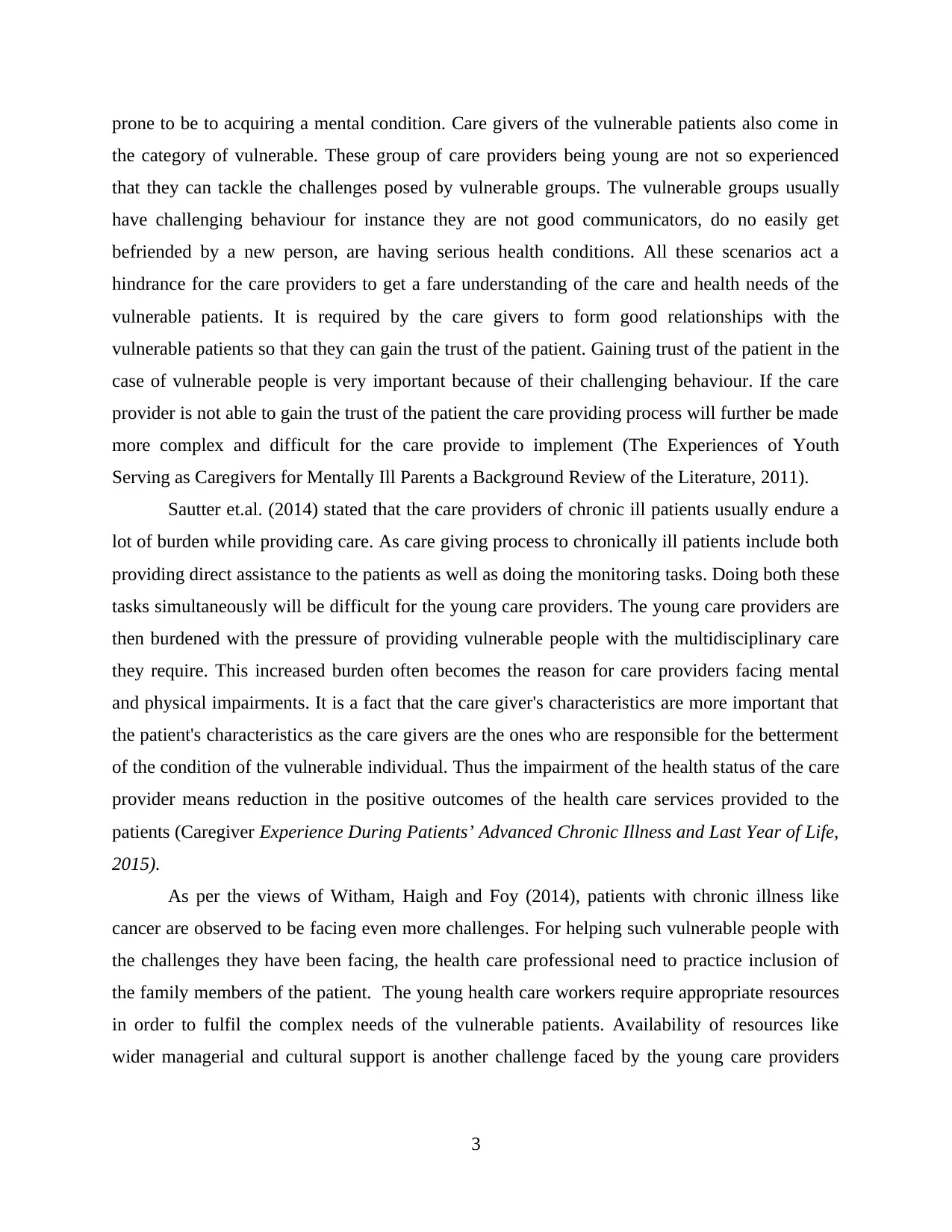
prone to be to acquiring a mental condition. Care givers of the vulnerable patients also come in
the category of vulnerable. These group of care providers being young are not so experienced
that they can tackle the challenges posed by vulnerable groups. The vulnerable groups usually
have challenging behaviour for instance they are not good communicators, do no easily get
befriended by a new person, are having serious health conditions. All these scenarios act a
hindrance for the care providers to get a fare understanding of the care and health needs of the
vulnerable patients. It is required by the care givers to form good relationships with the
vulnerable patients so that they can gain the trust of the patient. Gaining trust of the patient in the
case of vulnerable people is very important because of their challenging behaviour. If the care
provider is not able to gain the trust of the patient the care providing process will further be made
more complex and difficult for the care provide to implement (The Experiences of Youth
Serving as Caregivers for Mentally Ill Parents a Background Review of the Literature, 2011).
Sautter et.al. (2014) stated that the care providers of chronic ill patients usually endure a
lot of burden while providing care. As care giving process to chronically ill patients include both
providing direct assistance to the patients as well as doing the monitoring tasks. Doing both these
tasks simultaneously will be difficult for the young care providers. The young care providers are
then burdened with the pressure of providing vulnerable people with the multidisciplinary care
they require. This increased burden often becomes the reason for care providers facing mental
and physical impairments. It is a fact that the care giver's characteristics are more important that
the patient's characteristics as the care givers are the ones who are responsible for the betterment
of the condition of the vulnerable individual. Thus the impairment of the health status of the care
provider means reduction in the positive outcomes of the health care services provided to the
patients (Caregiver Experience During Patients’ Advanced Chronic Illness and Last Year of Life,
2015).
As per the views of Witham, Haigh and Foy (2014), patients with chronic illness like
cancer are observed to be facing even more challenges. For helping such vulnerable people with
the challenges they have been facing, the health care professional need to practice inclusion of
the family members of the patient. The young health care workers require appropriate resources
in order to fulfil the complex needs of the vulnerable patients. Availability of resources like
wider managerial and cultural support is another challenge faced by the young care providers
3
the category of vulnerable. These group of care providers being young are not so experienced
that they can tackle the challenges posed by vulnerable groups. The vulnerable groups usually
have challenging behaviour for instance they are not good communicators, do no easily get
befriended by a new person, are having serious health conditions. All these scenarios act a
hindrance for the care providers to get a fare understanding of the care and health needs of the
vulnerable patients. It is required by the care givers to form good relationships with the
vulnerable patients so that they can gain the trust of the patient. Gaining trust of the patient in the
case of vulnerable people is very important because of their challenging behaviour. If the care
provider is not able to gain the trust of the patient the care providing process will further be made
more complex and difficult for the care provide to implement (The Experiences of Youth
Serving as Caregivers for Mentally Ill Parents a Background Review of the Literature, 2011).
Sautter et.al. (2014) stated that the care providers of chronic ill patients usually endure a
lot of burden while providing care. As care giving process to chronically ill patients include both
providing direct assistance to the patients as well as doing the monitoring tasks. Doing both these
tasks simultaneously will be difficult for the young care providers. The young care providers are
then burdened with the pressure of providing vulnerable people with the multidisciplinary care
they require. This increased burden often becomes the reason for care providers facing mental
and physical impairments. It is a fact that the care giver's characteristics are more important that
the patient's characteristics as the care givers are the ones who are responsible for the betterment
of the condition of the vulnerable individual. Thus the impairment of the health status of the care
provider means reduction in the positive outcomes of the health care services provided to the
patients (Caregiver Experience During Patients’ Advanced Chronic Illness and Last Year of Life,
2015).
As per the views of Witham, Haigh and Foy (2014), patients with chronic illness like
cancer are observed to be facing even more challenges. For helping such vulnerable people with
the challenges they have been facing, the health care professional need to practice inclusion of
the family members of the patient. The young health care workers require appropriate resources
in order to fulfil the complex needs of the vulnerable patients. Availability of resources like
wider managerial and cultural support is another challenge faced by the young care providers
3
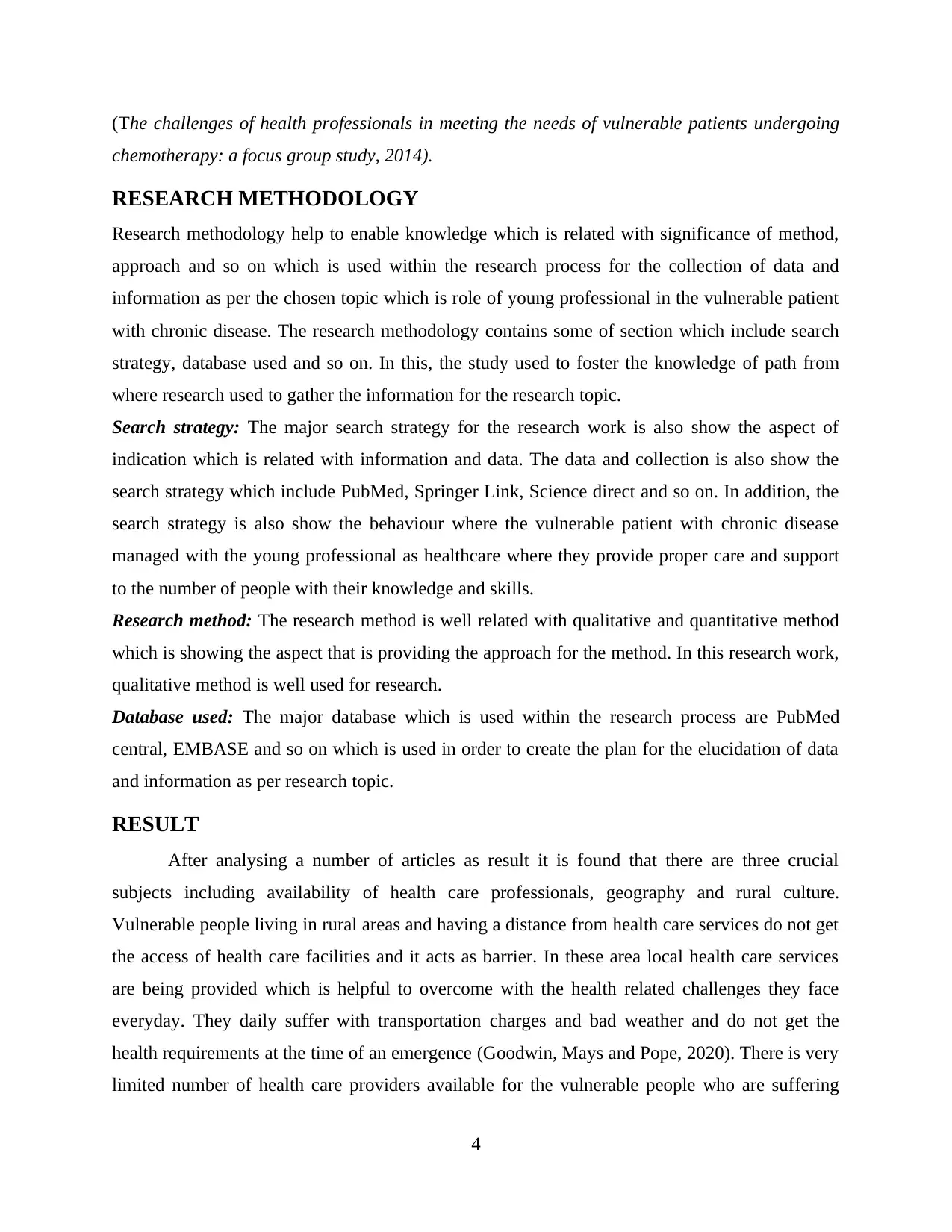
(The challenges of health professionals in meeting the needs of vulnerable patients undergoing
chemotherapy: a focus group study, 2014).
RESEARCH METHODOLOGY
Research methodology help to enable knowledge which is related with significance of method,
approach and so on which is used within the research process for the collection of data and
information as per the chosen topic which is role of young professional in the vulnerable patient
with chronic disease. The research methodology contains some of section which include search
strategy, database used and so on. In this, the study used to foster the knowledge of path from
where research used to gather the information for the research topic.
Search strategy: The major search strategy for the research work is also show the aspect of
indication which is related with information and data. The data and collection is also show the
search strategy which include PubMed, Springer Link, Science direct and so on. In addition, the
search strategy is also show the behaviour where the vulnerable patient with chronic disease
managed with the young professional as healthcare where they provide proper care and support
to the number of people with their knowledge and skills.
Research method: The research method is well related with qualitative and quantitative method
which is showing the aspect that is providing the approach for the method. In this research work,
qualitative method is well used for research.
Database used: The major database which is used within the research process are PubMed
central, EMBASE and so on which is used in order to create the plan for the elucidation of data
and information as per research topic.
RESULT
After analysing a number of articles as result it is found that there are three crucial
subjects including availability of health care professionals, geography and rural culture.
Vulnerable people living in rural areas and having a distance from health care services do not get
the access of health care facilities and it acts as barrier. In these area local health care services
are being provided which is helpful to overcome with the health related challenges they face
everyday. They daily suffer with transportation charges and bad weather and do not get the
health requirements at the time of an emergence (Goodwin, Mays and Pope, 2020). There is very
limited number of health care providers available for the vulnerable people who are suffering
4
chemotherapy: a focus group study, 2014).
RESEARCH METHODOLOGY
Research methodology help to enable knowledge which is related with significance of method,
approach and so on which is used within the research process for the collection of data and
information as per the chosen topic which is role of young professional in the vulnerable patient
with chronic disease. The research methodology contains some of section which include search
strategy, database used and so on. In this, the study used to foster the knowledge of path from
where research used to gather the information for the research topic.
Search strategy: The major search strategy for the research work is also show the aspect of
indication which is related with information and data. The data and collection is also show the
search strategy which include PubMed, Springer Link, Science direct and so on. In addition, the
search strategy is also show the behaviour where the vulnerable patient with chronic disease
managed with the young professional as healthcare where they provide proper care and support
to the number of people with their knowledge and skills.
Research method: The research method is well related with qualitative and quantitative method
which is showing the aspect that is providing the approach for the method. In this research work,
qualitative method is well used for research.
Database used: The major database which is used within the research process are PubMed
central, EMBASE and so on which is used in order to create the plan for the elucidation of data
and information as per research topic.
RESULT
After analysing a number of articles as result it is found that there are three crucial
subjects including availability of health care professionals, geography and rural culture.
Vulnerable people living in rural areas and having a distance from health care services do not get
the access of health care facilities and it acts as barrier. In these area local health care services
are being provided which is helpful to overcome with the health related challenges they face
everyday. They daily suffer with transportation charges and bad weather and do not get the
health requirements at the time of an emergence (Goodwin, Mays and Pope, 2020). There is very
limited number of health care providers available for the vulnerable people who are suffering
4
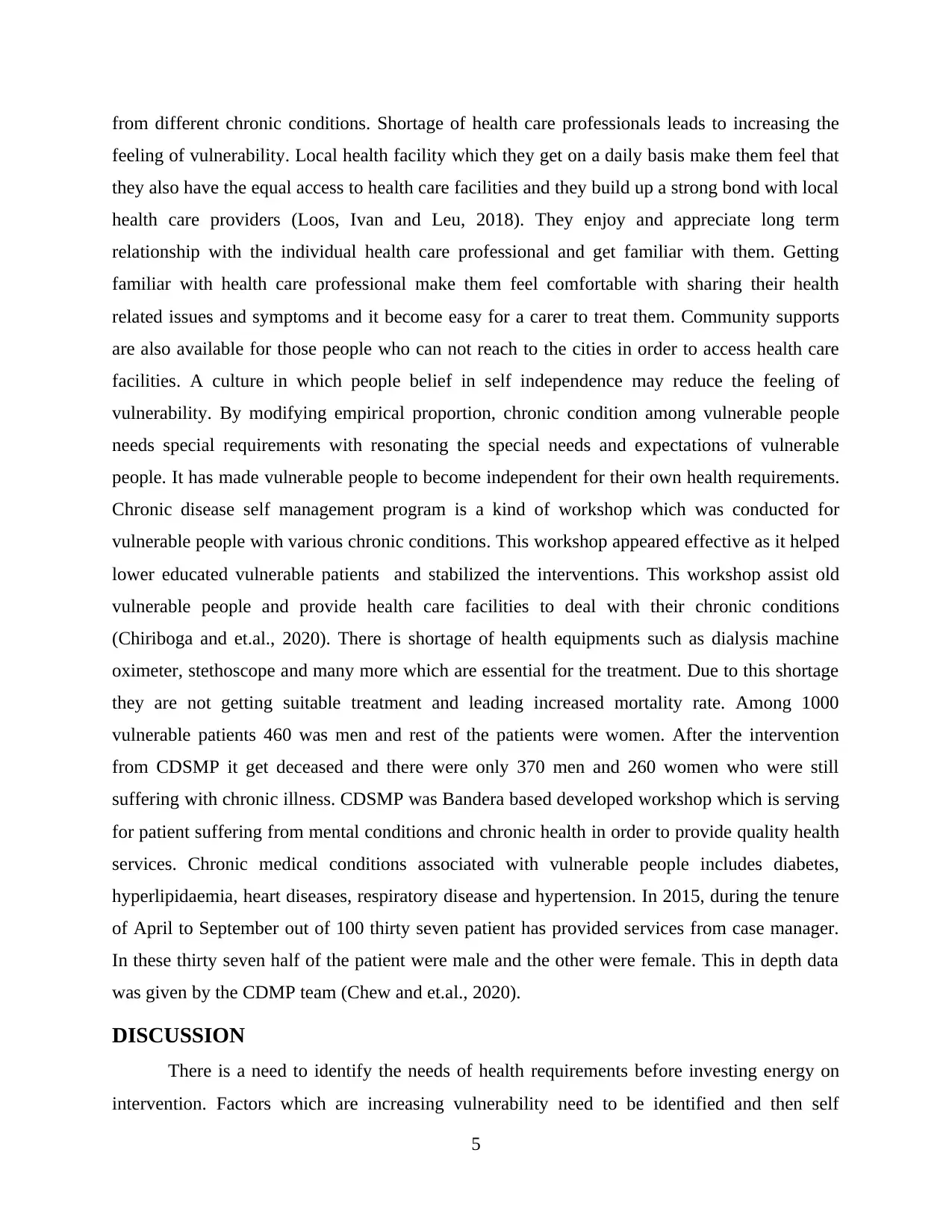
from different chronic conditions. Shortage of health care professionals leads to increasing the
feeling of vulnerability. Local health facility which they get on a daily basis make them feel that
they also have the equal access to health care facilities and they build up a strong bond with local
health care providers (Loos, Ivan and Leu, 2018). They enjoy and appreciate long term
relationship with the individual health care professional and get familiar with them. Getting
familiar with health care professional make them feel comfortable with sharing their health
related issues and symptoms and it become easy for a carer to treat them. Community supports
are also available for those people who can not reach to the cities in order to access health care
facilities. A culture in which people belief in self independence may reduce the feeling of
vulnerability. By modifying empirical proportion, chronic condition among vulnerable people
needs special requirements with resonating the special needs and expectations of vulnerable
people. It has made vulnerable people to become independent for their own health requirements.
Chronic disease self management program is a kind of workshop which was conducted for
vulnerable people with various chronic conditions. This workshop appeared effective as it helped
lower educated vulnerable patients and stabilized the interventions. This workshop assist old
vulnerable people and provide health care facilities to deal with their chronic conditions
(Chiriboga and et.al., 2020). There is shortage of health equipments such as dialysis machine
oximeter, stethoscope and many more which are essential for the treatment. Due to this shortage
they are not getting suitable treatment and leading increased mortality rate. Among 1000
vulnerable patients 460 was men and rest of the patients were women. After the intervention
from CDSMP it get deceased and there were only 370 men and 260 women who were still
suffering with chronic illness. CDSMP was Bandera based developed workshop which is serving
for patient suffering from mental conditions and chronic health in order to provide quality health
services. Chronic medical conditions associated with vulnerable people includes diabetes,
hyperlipidaemia, heart diseases, respiratory disease and hypertension. In 2015, during the tenure
of April to September out of 100 thirty seven patient has provided services from case manager.
In these thirty seven half of the patient were male and the other were female. This in depth data
was given by the CDMP team (Chew and et.al., 2020).
DISCUSSION
There is a need to identify the needs of health requirements before investing energy on
intervention. Factors which are increasing vulnerability need to be identified and then self
5
feeling of vulnerability. Local health facility which they get on a daily basis make them feel that
they also have the equal access to health care facilities and they build up a strong bond with local
health care providers (Loos, Ivan and Leu, 2018). They enjoy and appreciate long term
relationship with the individual health care professional and get familiar with them. Getting
familiar with health care professional make them feel comfortable with sharing their health
related issues and symptoms and it become easy for a carer to treat them. Community supports
are also available for those people who can not reach to the cities in order to access health care
facilities. A culture in which people belief in self independence may reduce the feeling of
vulnerability. By modifying empirical proportion, chronic condition among vulnerable people
needs special requirements with resonating the special needs and expectations of vulnerable
people. It has made vulnerable people to become independent for their own health requirements.
Chronic disease self management program is a kind of workshop which was conducted for
vulnerable people with various chronic conditions. This workshop appeared effective as it helped
lower educated vulnerable patients and stabilized the interventions. This workshop assist old
vulnerable people and provide health care facilities to deal with their chronic conditions
(Chiriboga and et.al., 2020). There is shortage of health equipments such as dialysis machine
oximeter, stethoscope and many more which are essential for the treatment. Due to this shortage
they are not getting suitable treatment and leading increased mortality rate. Among 1000
vulnerable patients 460 was men and rest of the patients were women. After the intervention
from CDSMP it get deceased and there were only 370 men and 260 women who were still
suffering with chronic illness. CDSMP was Bandera based developed workshop which is serving
for patient suffering from mental conditions and chronic health in order to provide quality health
services. Chronic medical conditions associated with vulnerable people includes diabetes,
hyperlipidaemia, heart diseases, respiratory disease and hypertension. In 2015, during the tenure
of April to September out of 100 thirty seven patient has provided services from case manager.
In these thirty seven half of the patient were male and the other were female. This in depth data
was given by the CDMP team (Chew and et.al., 2020).
DISCUSSION
There is a need to identify the needs of health requirements before investing energy on
intervention. Factors which are increasing vulnerability need to be identified and then self
5
Paraphrase This Document
Need a fresh take? Get an instant paraphrase of this document with our AI Paraphraser
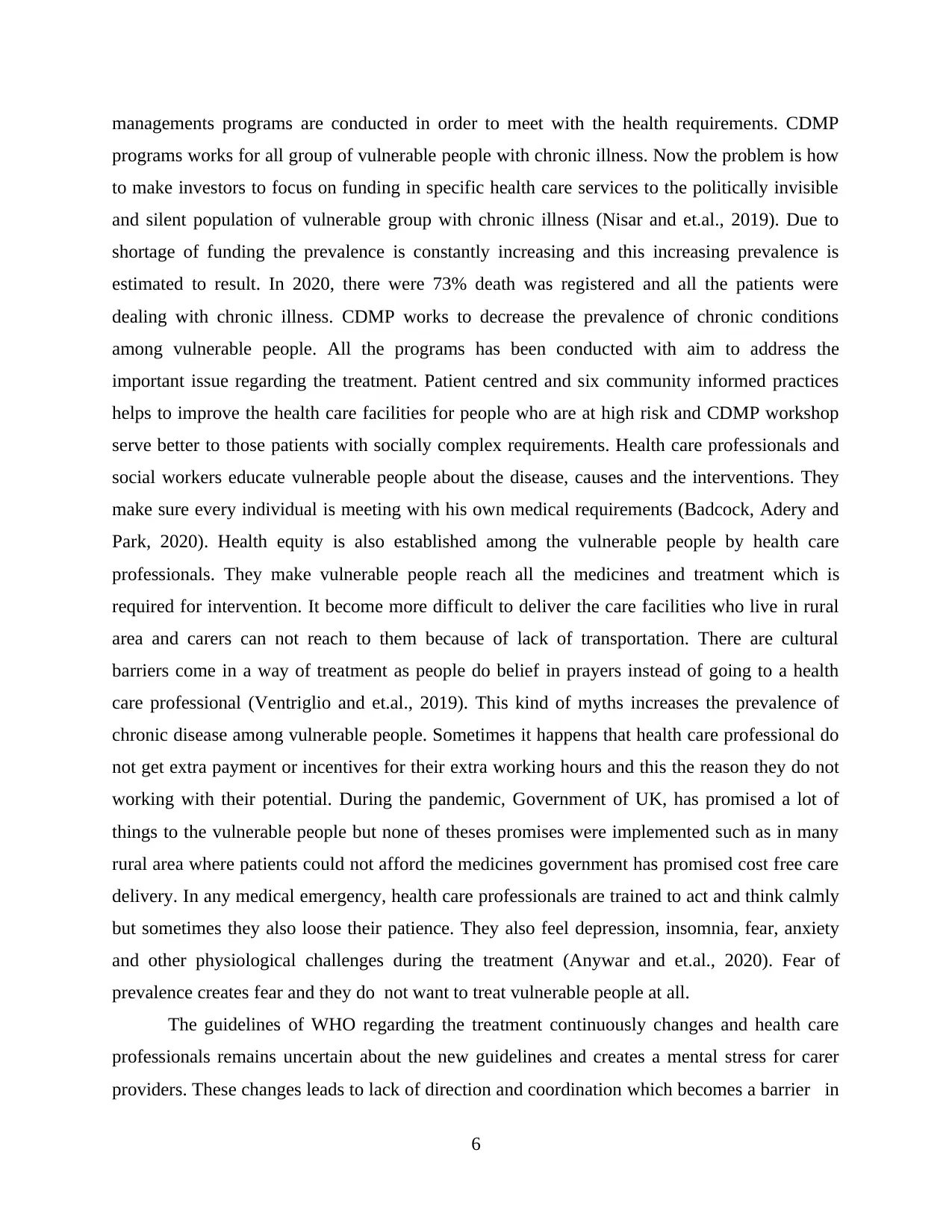
managements programs are conducted in order to meet with the health requirements. CDMP
programs works for all group of vulnerable people with chronic illness. Now the problem is how
to make investors to focus on funding in specific health care services to the politically invisible
and silent population of vulnerable group with chronic illness (Nisar and et.al., 2019). Due to
shortage of funding the prevalence is constantly increasing and this increasing prevalence is
estimated to result. In 2020, there were 73% death was registered and all the patients were
dealing with chronic illness. CDMP works to decrease the prevalence of chronic conditions
among vulnerable people. All the programs has been conducted with aim to address the
important issue regarding the treatment. Patient centred and six community informed practices
helps to improve the health care facilities for people who are at high risk and CDMP workshop
serve better to those patients with socially complex requirements. Health care professionals and
social workers educate vulnerable people about the disease, causes and the interventions. They
make sure every individual is meeting with his own medical requirements (Badcock, Adery and
Park, 2020). Health equity is also established among the vulnerable people by health care
professionals. They make vulnerable people reach all the medicines and treatment which is
required for intervention. It become more difficult to deliver the care facilities who live in rural
area and carers can not reach to them because of lack of transportation. There are cultural
barriers come in a way of treatment as people do belief in prayers instead of going to a health
care professional (Ventriglio and et.al., 2019). This kind of myths increases the prevalence of
chronic disease among vulnerable people. Sometimes it happens that health care professional do
not get extra payment or incentives for their extra working hours and this the reason they do not
working with their potential. During the pandemic, Government of UK, has promised a lot of
things to the vulnerable people but none of theses promises were implemented such as in many
rural area where patients could not afford the medicines government has promised cost free care
delivery. In any medical emergency, health care professionals are trained to act and think calmly
but sometimes they also loose their patience. They also feel depression, insomnia, fear, anxiety
and other physiological challenges during the treatment (Anywar and et.al., 2020). Fear of
prevalence creates fear and they do not want to treat vulnerable people at all.
The guidelines of WHO regarding the treatment continuously changes and health care
professionals remains uncertain about the new guidelines and creates a mental stress for carer
providers. These changes leads to lack of direction and coordination which becomes a barrier in
6
programs works for all group of vulnerable people with chronic illness. Now the problem is how
to make investors to focus on funding in specific health care services to the politically invisible
and silent population of vulnerable group with chronic illness (Nisar and et.al., 2019). Due to
shortage of funding the prevalence is constantly increasing and this increasing prevalence is
estimated to result. In 2020, there were 73% death was registered and all the patients were
dealing with chronic illness. CDMP works to decrease the prevalence of chronic conditions
among vulnerable people. All the programs has been conducted with aim to address the
important issue regarding the treatment. Patient centred and six community informed practices
helps to improve the health care facilities for people who are at high risk and CDMP workshop
serve better to those patients with socially complex requirements. Health care professionals and
social workers educate vulnerable people about the disease, causes and the interventions. They
make sure every individual is meeting with his own medical requirements (Badcock, Adery and
Park, 2020). Health equity is also established among the vulnerable people by health care
professionals. They make vulnerable people reach all the medicines and treatment which is
required for intervention. It become more difficult to deliver the care facilities who live in rural
area and carers can not reach to them because of lack of transportation. There are cultural
barriers come in a way of treatment as people do belief in prayers instead of going to a health
care professional (Ventriglio and et.al., 2019). This kind of myths increases the prevalence of
chronic disease among vulnerable people. Sometimes it happens that health care professional do
not get extra payment or incentives for their extra working hours and this the reason they do not
working with their potential. During the pandemic, Government of UK, has promised a lot of
things to the vulnerable people but none of theses promises were implemented such as in many
rural area where patients could not afford the medicines government has promised cost free care
delivery. In any medical emergency, health care professionals are trained to act and think calmly
but sometimes they also loose their patience. They also feel depression, insomnia, fear, anxiety
and other physiological challenges during the treatment (Anywar and et.al., 2020). Fear of
prevalence creates fear and they do not want to treat vulnerable people at all.
The guidelines of WHO regarding the treatment continuously changes and health care
professionals remains uncertain about the new guidelines and creates a mental stress for carer
providers. These changes leads to lack of direction and coordination which becomes a barrier in
6
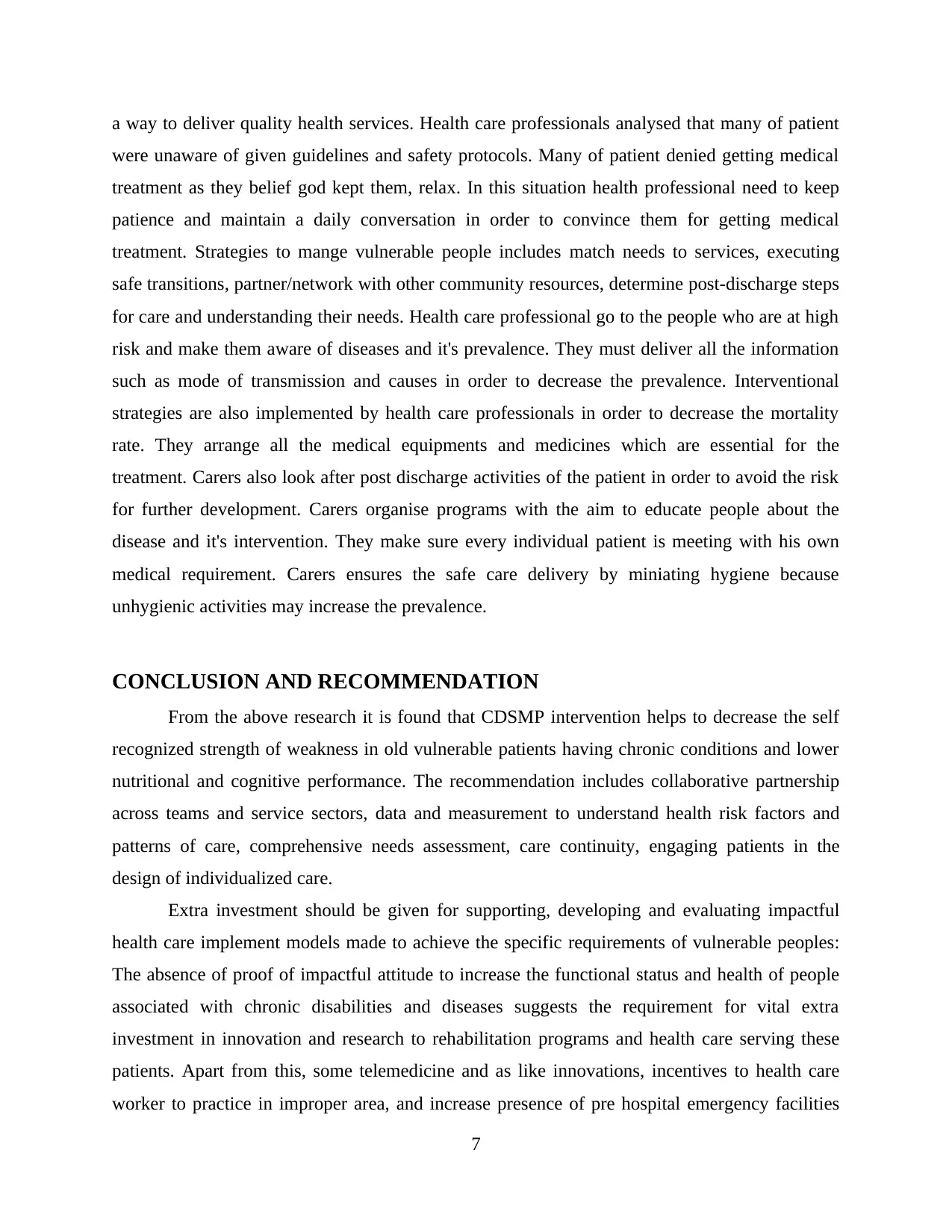
a way to deliver quality health services. Health care professionals analysed that many of patient
were unaware of given guidelines and safety protocols. Many of patient denied getting medical
treatment as they belief god kept them, relax. In this situation health professional need to keep
patience and maintain a daily conversation in order to convince them for getting medical
treatment. Strategies to mange vulnerable people includes match needs to services, executing
safe transitions, partner/network with other community resources, determine post-discharge steps
for care and understanding their needs. Health care professional go to the people who are at high
risk and make them aware of diseases and it's prevalence. They must deliver all the information
such as mode of transmission and causes in order to decrease the prevalence. Interventional
strategies are also implemented by health care professionals in order to decrease the mortality
rate. They arrange all the medical equipments and medicines which are essential for the
treatment. Carers also look after post discharge activities of the patient in order to avoid the risk
for further development. Carers organise programs with the aim to educate people about the
disease and it's intervention. They make sure every individual patient is meeting with his own
medical requirement. Carers ensures the safe care delivery by miniating hygiene because
unhygienic activities may increase the prevalence.
CONCLUSION AND RECOMMENDATION
From the above research it is found that CDSMP intervention helps to decrease the self
recognized strength of weakness in old vulnerable patients having chronic conditions and lower
nutritional and cognitive performance. The recommendation includes collaborative partnership
across teams and service sectors, data and measurement to understand health risk factors and
patterns of care, comprehensive needs assessment, care continuity, engaging patients in the
design of individualized care.
Extra investment should be given for supporting, developing and evaluating impactful
health care implement models made to achieve the specific requirements of vulnerable peoples:
The absence of proof of impactful attitude to increase the functional status and health of people
associated with chronic disabilities and diseases suggests the requirement for vital extra
investment in innovation and research to rehabilitation programs and health care serving these
patients. Apart from this, some telemedicine and as like innovations, incentives to health care
worker to practice in improper area, and increase presence of pre hospital emergency facilities
7
were unaware of given guidelines and safety protocols. Many of patient denied getting medical
treatment as they belief god kept them, relax. In this situation health professional need to keep
patience and maintain a daily conversation in order to convince them for getting medical
treatment. Strategies to mange vulnerable people includes match needs to services, executing
safe transitions, partner/network with other community resources, determine post-discharge steps
for care and understanding their needs. Health care professional go to the people who are at high
risk and make them aware of diseases and it's prevalence. They must deliver all the information
such as mode of transmission and causes in order to decrease the prevalence. Interventional
strategies are also implemented by health care professionals in order to decrease the mortality
rate. They arrange all the medical equipments and medicines which are essential for the
treatment. Carers also look after post discharge activities of the patient in order to avoid the risk
for further development. Carers organise programs with the aim to educate people about the
disease and it's intervention. They make sure every individual patient is meeting with his own
medical requirement. Carers ensures the safe care delivery by miniating hygiene because
unhygienic activities may increase the prevalence.
CONCLUSION AND RECOMMENDATION
From the above research it is found that CDSMP intervention helps to decrease the self
recognized strength of weakness in old vulnerable patients having chronic conditions and lower
nutritional and cognitive performance. The recommendation includes collaborative partnership
across teams and service sectors, data and measurement to understand health risk factors and
patterns of care, comprehensive needs assessment, care continuity, engaging patients in the
design of individualized care.
Extra investment should be given for supporting, developing and evaluating impactful
health care implement models made to achieve the specific requirements of vulnerable peoples:
The absence of proof of impactful attitude to increase the functional status and health of people
associated with chronic disabilities and diseases suggests the requirement for vital extra
investment in innovation and research to rehabilitation programs and health care serving these
patients. Apart from this, some telemedicine and as like innovations, incentives to health care
worker to practice in improper area, and increase presence of pre hospital emergency facilities
7
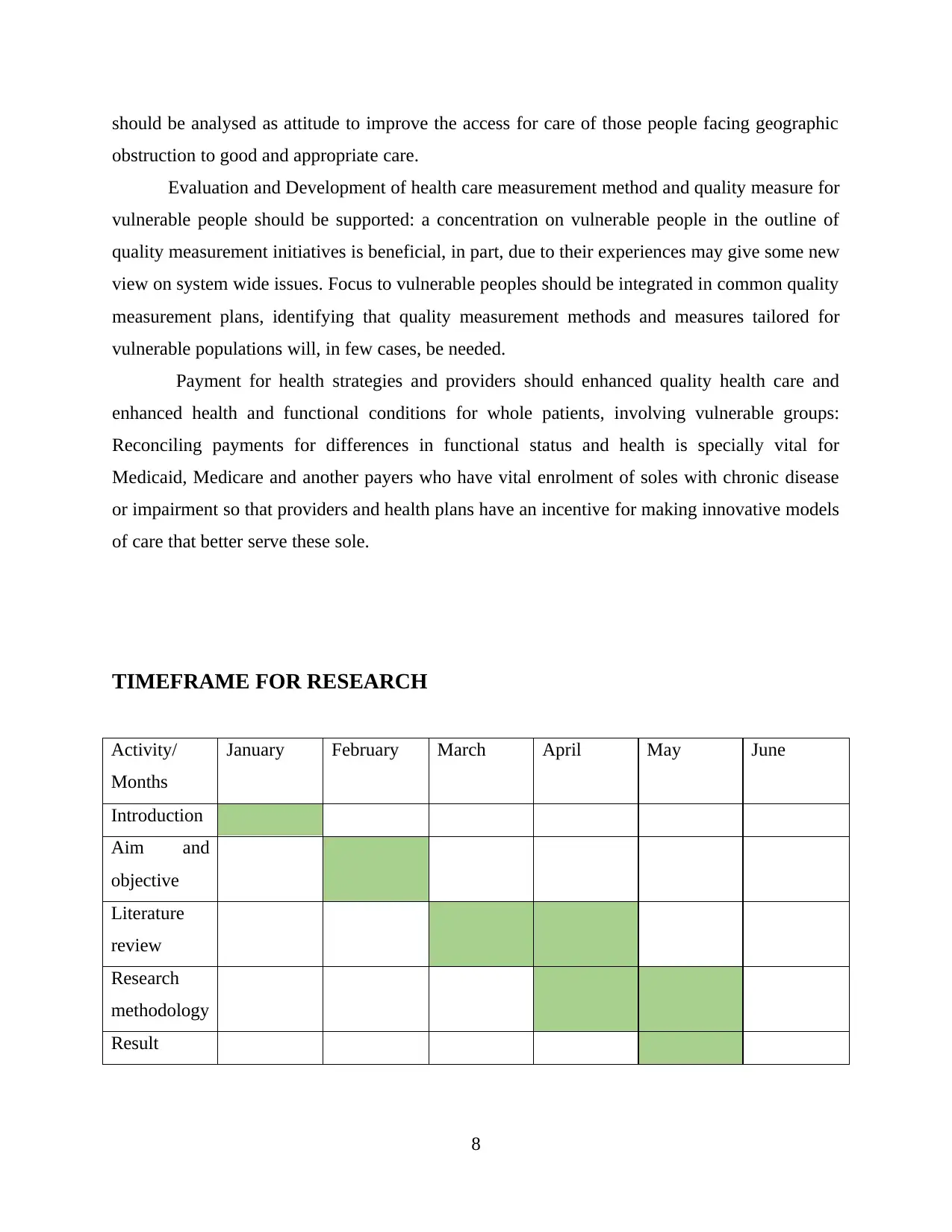
should be analysed as attitude to improve the access for care of those people facing geographic
obstruction to good and appropriate care.
Evaluation and Development of health care measurement method and quality measure for
vulnerable people should be supported: a concentration on vulnerable people in the outline of
quality measurement initiatives is beneficial, in part, due to their experiences may give some new
view on system wide issues. Focus to vulnerable peoples should be integrated in common quality
measurement plans, identifying that quality measurement methods and measures tailored for
vulnerable populations will, in few cases, be needed.
Payment for health strategies and providers should enhanced quality health care and
enhanced health and functional conditions for whole patients, involving vulnerable groups:
Reconciling payments for differences in functional status and health is specially vital for
Medicaid, Medicare and another payers who have vital enrolment of soles with chronic disease
or impairment so that providers and health plans have an incentive for making innovative models
of care that better serve these sole.
TIMEFRAME FOR RESEARCH
Activity/
Months
January February March April May June
Introduction
Aim and
objective
Literature
review
Research
methodology
Result
8
obstruction to good and appropriate care.
Evaluation and Development of health care measurement method and quality measure for
vulnerable people should be supported: a concentration on vulnerable people in the outline of
quality measurement initiatives is beneficial, in part, due to their experiences may give some new
view on system wide issues. Focus to vulnerable peoples should be integrated in common quality
measurement plans, identifying that quality measurement methods and measures tailored for
vulnerable populations will, in few cases, be needed.
Payment for health strategies and providers should enhanced quality health care and
enhanced health and functional conditions for whole patients, involving vulnerable groups:
Reconciling payments for differences in functional status and health is specially vital for
Medicaid, Medicare and another payers who have vital enrolment of soles with chronic disease
or impairment so that providers and health plans have an incentive for making innovative models
of care that better serve these sole.
TIMEFRAME FOR RESEARCH
Activity/
Months
January February March April May June
Introduction
Aim and
objective
Literature
review
Research
methodology
Result
8
Secure Best Marks with AI Grader
Need help grading? Try our AI Grader for instant feedback on your assignments.
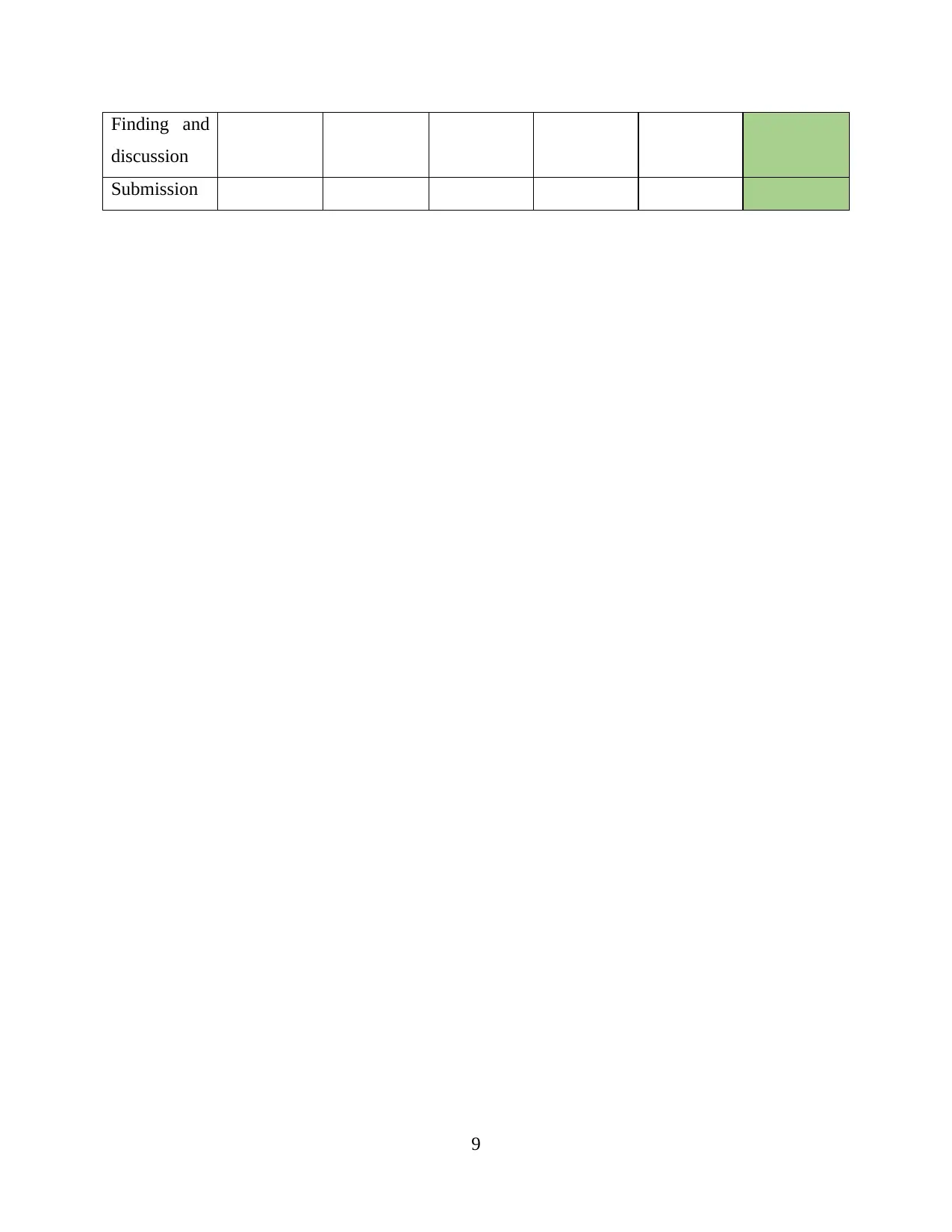
Finding and
discussion
Submission
9
discussion
Submission
9
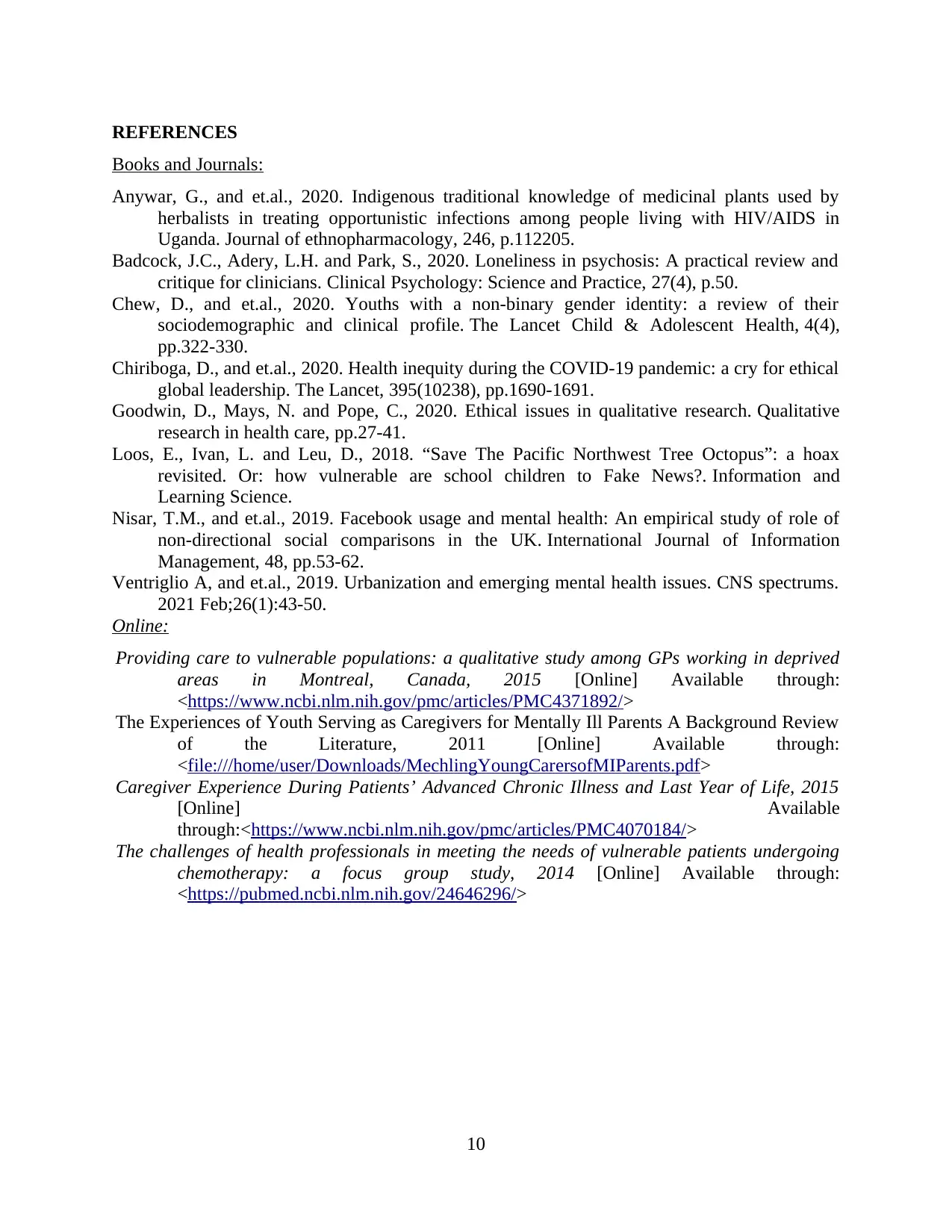
REFERENCES
Books and Journals:
Anywar, G., and et.al., 2020. Indigenous traditional knowledge of medicinal plants used by
herbalists in treating opportunistic infections among people living with HIV/AIDS in
Uganda. Journal of ethnopharmacology, 246, p.112205.
Badcock, J.C., Adery, L.H. and Park, S., 2020. Loneliness in psychosis: A practical review and
critique for clinicians. Clinical Psychology: Science and Practice, 27(4), p.50.
Chew, D., and et.al., 2020. Youths with a non-binary gender identity: a review of their
sociodemographic and clinical profile. The Lancet Child & Adolescent Health, 4(4),
pp.322-330.
Chiriboga, D., and et.al., 2020. Health inequity during the COVID-19 pandemic: a cry for ethical
global leadership. The Lancet, 395(10238), pp.1690-1691.
Goodwin, D., Mays, N. and Pope, C., 2020. Ethical issues in qualitative research. Qualitative
research in health care, pp.27-41.
Loos, E., Ivan, L. and Leu, D., 2018. “Save The Pacific Northwest Tree Octopus”: a hoax
revisited. Or: how vulnerable are school children to Fake News?. Information and
Learning Science.
Nisar, T.M., and et.al., 2019. Facebook usage and mental health: An empirical study of role of
non-directional social comparisons in the UK. International Journal of Information
Management, 48, pp.53-62.
Ventriglio A, and et.al., 2019. Urbanization and emerging mental health issues. CNS spectrums.
2021 Feb;26(1):43-50.
Online:
Providing care to vulnerable populations: a qualitative study among GPs working in deprived
areas in Montreal, Canada, 2015 [Online] Available through:
<https://www.ncbi.nlm.nih.gov/pmc/articles/PMC4371892/>
The Experiences of Youth Serving as Caregivers for Mentally Ill Parents A Background Review
of the Literature, 2011 [Online] Available through:
<file:///home/user/Downloads/MechlingYoungCarersofMIParents.pdf>
Caregiver Experience During Patients’ Advanced Chronic Illness and Last Year of Life, 2015
[Online] Available
through:<https://www.ncbi.nlm.nih.gov/pmc/articles/PMC4070184/>
The challenges of health professionals in meeting the needs of vulnerable patients undergoing
chemotherapy: a focus group study, 2014 [Online] Available through:
<https://pubmed.ncbi.nlm.nih.gov/24646296/>
10
Books and Journals:
Anywar, G., and et.al., 2020. Indigenous traditional knowledge of medicinal plants used by
herbalists in treating opportunistic infections among people living with HIV/AIDS in
Uganda. Journal of ethnopharmacology, 246, p.112205.
Badcock, J.C., Adery, L.H. and Park, S., 2020. Loneliness in psychosis: A practical review and
critique for clinicians. Clinical Psychology: Science and Practice, 27(4), p.50.
Chew, D., and et.al., 2020. Youths with a non-binary gender identity: a review of their
sociodemographic and clinical profile. The Lancet Child & Adolescent Health, 4(4),
pp.322-330.
Chiriboga, D., and et.al., 2020. Health inequity during the COVID-19 pandemic: a cry for ethical
global leadership. The Lancet, 395(10238), pp.1690-1691.
Goodwin, D., Mays, N. and Pope, C., 2020. Ethical issues in qualitative research. Qualitative
research in health care, pp.27-41.
Loos, E., Ivan, L. and Leu, D., 2018. “Save The Pacific Northwest Tree Octopus”: a hoax
revisited. Or: how vulnerable are school children to Fake News?. Information and
Learning Science.
Nisar, T.M., and et.al., 2019. Facebook usage and mental health: An empirical study of role of
non-directional social comparisons in the UK. International Journal of Information
Management, 48, pp.53-62.
Ventriglio A, and et.al., 2019. Urbanization and emerging mental health issues. CNS spectrums.
2021 Feb;26(1):43-50.
Online:
Providing care to vulnerable populations: a qualitative study among GPs working in deprived
areas in Montreal, Canada, 2015 [Online] Available through:
<https://www.ncbi.nlm.nih.gov/pmc/articles/PMC4371892/>
The Experiences of Youth Serving as Caregivers for Mentally Ill Parents A Background Review
of the Literature, 2011 [Online] Available through:
<file:///home/user/Downloads/MechlingYoungCarersofMIParents.pdf>
Caregiver Experience During Patients’ Advanced Chronic Illness and Last Year of Life, 2015
[Online] Available
through:<https://www.ncbi.nlm.nih.gov/pmc/articles/PMC4070184/>
The challenges of health professionals in meeting the needs of vulnerable patients undergoing
chemotherapy: a focus group study, 2014 [Online] Available through:
<https://pubmed.ncbi.nlm.nih.gov/24646296/>
10
1 out of 12
Related Documents
Your All-in-One AI-Powered Toolkit for Academic Success.
+13062052269
info@desklib.com
Available 24*7 on WhatsApp / Email
![[object Object]](/_next/static/media/star-bottom.7253800d.svg)
Unlock your academic potential
© 2024 | Zucol Services PVT LTD | All rights reserved.





